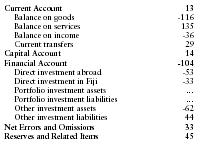Fiji - Balance of payments
Fiji has traditionally had an annual trade deficit and an annual deficit on current accounts. Long-term capital inflows, both public and private, generally cover the deficits; however in 1991, the trade deficit was $37 million, down from $84 million in 1990. By 1992, the current account balance registered a surplus (as in 1989), due to increased earnings from exported sugar cane and growing tourism. The next year, however, deficits returned, but by 1996, the government was again posting a surplus. In 1997, Fiji just about broke even, but the 1998 figure reported a current account deficit equal to 2.5% of the GDP. A banking collapse due to mismanagement and corruption in the National Bank of Fiji severely damaged the financial account that year.
In addition to sugar exports, strong garment exports and agricultural exports other than sugar were expected to improve the balance of payments situation in the early 2000s.
The US Central Intelligence Agency (CIA) reports that in 2000 the purchasing power parity of Fiji's exports was $572 million while imports totaled $833 million resulting in a trade deficit of $261 million.
The International Monetary Fund (IMF) reports that in 1999 Fiji had exports of goods totaling $538 million and imports totaling $653 million. The services credit totaled $525 million and debit $390 million. The following table summarizes Fiji's balance of payments as reported by the IMF for 1999 in millions of US dollars.

| Current Account | 13 |
| Balance on goods | -116 |
| Balance on services | 135 |
| Balance on income | -36 |
| Current transfers | 29 |
| Capital Account | 14 |
| Financial Account | -104 |
| Direct investment abroad | -53 |
| Direct investment in Fiji | -33 |
| Portfolio investment assets | … |
| Portfolio investment liabilities | … |
| Other investment assets | -62 |
| Other investment liabilities | 44 |
| Net Errors and Omissions | 33 |
| Reserves and Related Items | 45 |
Comment about this article, ask questions, or add new information about this topic: